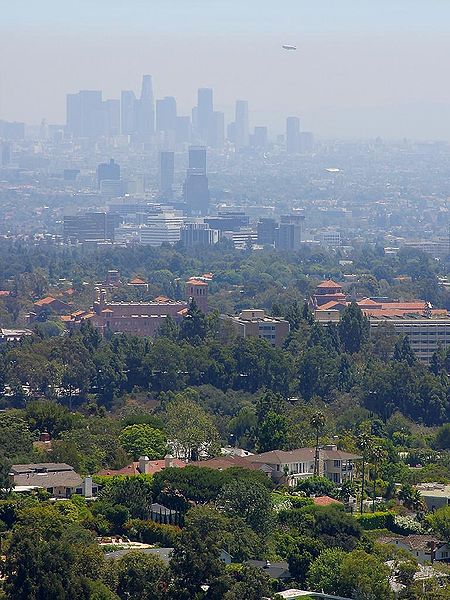
Haze
Traditionally an atmospheric phenomenon where dust, smoke and other dry particles obscure the clarity of the sky. The World Meteorological Organization manual of codes includes a classification of horizontal obscuration into categories of fog, ice fog, steam fog, mist, haze, smoke, volcanic ash, dust, sand and snow. Sources for haze particles include farming (ploughing in dry weather), traffic, industry, and wildfires.
Seen from afar (e.g. approaching airplane) and depending upon the direction of view with respect to the sun, haze may appear brownish or bluish, while mist tends to be bluish-grey. Whereas haze often is thought of as a phenomenon of dry air, mist formation is a phenomenon of humid air. However, haze particles may act as condensation nuclei for the subsequent formation of mist droplets; such forms of haze are known as "wet haze."
In the United States and elsewhere, the term "haze" in meteorological literature generally is used to denote visibility-reducing aerosols of the wet type. Such aerosols commonly arise from complex chemical reactions that occur as sulfur dioxide gases emitted during combustion are converted into small droplets of sulfuric acid. The reactions are enhanced in the presence of sunlight, high relative humidity, and stagnant air flow. A small component of wet haze aerosols appear to be derived from compounds released by trees, such as terpenes. For all these reasons, wet haze tends to be primarily a warm-season phenomenon. Large areas of haze covering many thousands of kilometers may be produced under favorable conditions each summer.
Air Pollution
Haze often occurs when dust and smoke particles accumulate in relatively dry air. When weather conditions block the dispersal of smoke and other pollutants they concentrate and form a usually low-hanging shroud that impairs visibility and may become a respiratory health threat. Industrial pollution can result in dense haze, which is known as smog.
Haze causes issues in the area of terrestrial photography, where the penetration of large amounts of dense atmosphere may be necessary to image distant subjects. This results in the visual effect of a loss of contrast in the subject, due to the effect of light scattering through the haze particles. For these reasons, sunrise and sunset colors appear subdued on hazy days, and stars may be obscured at night. In some cases, attenuation by haze is so great that, toward sunset, the sun disappears altogether before reaching the horizon. Haze can be defined as an aerial form of the Tyndall effect therefore unlike other atmospheric effects such as cloud and fog, haze is spectrally selective: shorter (blue) wavelengths are scattered more, and longer (red/infrared) wavelengths are scattered less. For this reason many super-telephoto lenses often incorporate yellow filters or coatings to enhance image contrast.
Infrared (IR) imaging may also be used to penetrate haze over long distances, with a combination of IR-pass optical filters (such as the Wratten 89B) and IR-sensitive detector.